This page contains affiliate links. We may earn money or products from the companies mentioned in this post through our independently chosen links, which earn us a commission. Learn More
The frequency and measure of the food you feed to your puppy is very essential to his future health and behavior. It’s important to feed your puppy with high-quality food. As per how much you should feed your puppy, that really comes down to the age and the weight of the puppy.
As owners and breeders, you’d want to do right for your new furball. One of the most important and best ways to do that is by keeping your pet healthy.
Luckily, you have control over something that will help your pup stay in tip-top shape – feeding.
Related:
Best Puppy Food to Feed Your New Pup
Contents & Quick Navigation
Prioritize proper nutrition when feeding a puppy
You’ll be setting up a great foundation for the puppies’ development by making sure they are getting proper nutrition. That’s why it’s important to know that puppies need food that’s specifically formulated for them.
Puppies grow rapidly and their food provides complete and balanced nutrients so that they grow happy and healthy.
Food made for adult dogs doesn’t give the essential nutrients a growing puppy needs.
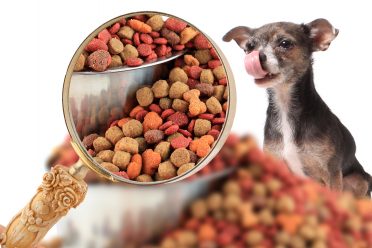
Look for a puppy dog food that is rich in protein to help support those growing muscles. Carbohydrates will supply the needed energy for their playtime and stay active. For those developing bones and teeth, calcium is very important.
Fatty acids such as DHA (docosahexaenoic acid) that are commonly found in fish oil, will improve the memory and learning of canines!
Basically, younger dogs require higher levels of nutrients.
Keep in mind that there is an ideal window, though. If puppies don’t get enough essential nutrients, then it can lead to deficiencies. If they get too much of some, then it may cause complications.
What to feed newborn puppies?
For breeders, even first-time puppy owners, we know that the litter would be feeding straight from their mom. But there are times where a puppy (or more) would need help from us during their first week or so.
Since we mentioned “foundation”, the best start for puppies is to get colostrum during their 12 to 48 hours of life.

Colostrum from their mother’s milk will give the puppies immunity to germs and diseases that they may encounter during their first few weeks. This transfer of antibodies occurs only until their intestine develops the ability to screen out large molecules.
The change in the intestine occurs very quickly in the first few hours of life, that’s why the puppies should nurse right away and continuously.
Feeding a newborn pup on your own
What if one of the pups (or more) is too weak? Then you, as an owner, would have to step in.
There’s often the possibility that a puppy has trouble latching or nursing. Some of those reasons can be:
- The dam has a poor appetite or not drinking enough fluids
- The mother dog has poor milk let down
- Puppies born via cesarean or C-Section
- Slow development in the puppies
- The dam has a fever
- A runt or fading puppy
Since those little furballs need your help, you would have to get milk directly from their mother.
Before handling and feeding a newborn puppy, make sure you washed your hands thoroughly or sanitized.
Some would use their finger to feed the puppy to see if they’d drink it and to hint that it’s feeding time. If yes, then you can use a dropper or syringe. Since a bottle would seem more natural to use for them to feed so they can also suck, here’s a video on how to feed newborn pups.
Don’t forget to remove a weak pup or runt from the whelping box. Make sure the little doggo has its own and the best crate to stay in while you take care of her back to recovery.
Keep your pup in a place where there’s heat source (like a lightbulb or heating pad), feed, and gently stimulate the puppy to urinate and defecate.
For those whose dog has a large litter, you can avoid draining and damaging the bitch by supplementary feeding the puppies. It will also help prevent eclampsia (hypocalcemia). It’s a health issue that is always a worry when female dogs give birth to a large litter. It happens anywhere between 2 to 3 weeks before and after whelping.
Using Milk Replacers for feeding puppies
If nursing from the mother dog or getting milk from her is not an option, then you would have to look for a replacement.

DON’T use formulas made for human infants, or even cow’s or goat’s milk. Every species’ milk is uniquely tailored for their growing young’s needs.
It’s best to choose alternative nourishment that is specifically made for puppies. If ever your pup is not allergic to these kinds of milk, doesn’t get an upset stomach, or can simply tolerate it, still incorporate products designed for a puppy.
Supplemental ingredients will help make up for what the milk you’re using lacks compared to puppy milk.
To start your search, here are the top milk replacement for pups:
- Esbilac Puppy Milk Replacer Powder
- Nutri-Vet Milk Replacement for Puppies
- Goat’s Milk Esbilac
- PetLac Milk Powder for Puppies
- Manna Pro Nurse All Non-Medicated Milk Replacer
Feeding puppies using a tube – yay or nay?
Our say on this – nay!
It’s understandable that tube feeding is a faster and easier method when it comes to dealing with a puppy or a whole litter. This is assuming that you are certain you’re getting the tube in the esophagus leading to the stomach, and not the trachea which leads to their lungs.
So we advise you not to tube the lil doggos if nursing isn’t an option at all, because it’s deadly. Not unless it’s the only way to feed a puppy due to a medical condition or the pup is just too weak to suck.
Just like this video where a puppy has a cleft palate and is fed using a tube.
But did you know, that when we eat, the process of eating stimulates waves of contraction throughout our entire GI (gastrointestinal) tract?
Those waves of contraction are called peristalsis, and the reaction of the puppies when they nurse is to defecate.
So if a puppy won’t nurse or it doesn’t have a good sucking reflex, peristalsis will not happen. Meaning, we force milk in them using a tube and it will just sit in their tummy. Once the tube is removed, the milk forces itself back up the esophagus into the trachea and ends up in the lungs.
Even if you put in the tube right, a puppy’s stomach is not that big. So what should you do instead?
We give the puppies sugar in salt water, which is the solution used for IV therapy. It’s known as subcutaneous (subQ) dextrose and saline.
After all, everyone in the litter needs warmth, sugar, and water. It’s these three things that they require as soon as they are born and for an additional few days, if necessary.
If your vet or breeder already taught you how to administer the subQ fluid at home, but you want to see it one more time, just watch this video:
If you’re wondering how much fluid you should give to a weak puppy, provide enough to satisfy the current dehydration debt. That includes providing a cushion for an hour or two in the future. Generally, it’s enough when you refill the syringe with dextrose and saline, and the last 10cc injection you’ve given hasn’t already disappeared.
Remember, if the puppy is already dehydrated, the fluids you provide will disappear quickly.
Weaning newborn puppies from milk
Whether the puppies are nursing from their mother or you’re the one feeding them milk through a bottle or syringe, they eventually have to stop.
Gradually reducing a puppy’s dependency on their mom for food and care will help the little one do things on its own.
When to wean puppies?
You can begin weaning a puppy or litter around 3 and 4 weeks old. You would notice that they’re more independent by the time they turn 7 to 8 weeks of age. We emphasize that this process should be done gradually, meaning it would happen over several weeks.
The growing little dogs need time to incorporate the important traits they got from their littermates and mother with what they’re currently learning.
But weaning brings stress to the mother dog and her pups, so not only should it be gradual, but it should also be supervised.
How to start weaning a litter
The first thing to do is have the pups move out from the whelping box.
Take this time to introduce the furballs to a pan or bowl where they can eat and drink on their own.

Remember, everything should be a slow process, that includes the frequency and amount of food, as well as length of separation. This is not a race.
As the pups become self-confident and independent, there will be no trouble for them to spend more time away from mom.
If a puppy hesitates on drinking or eating on their own, just dip your finger in the milk and then let them suck or lick it.
You should never force their face and nose into their bowl or pan.
The type of food to use when weaning puppies
You can only use puppy food moistened with milk replacers or warm water during this process.
Create an appealing meal for their sensitive palates – a soupy gruel. You may need to encourage those puppies during the first few feedings, but most of the time, they quickly learn on their own.
Always take into consideration the breed size of the litter when choosing the type of puppy food. If you need help in making sure that the pups are progressing normally, bring them to the vet.
Different types of dog food to feed your weaned puppy

There are a lot of options for best puppy food out there and that can be overwhelming.
The important factors that you would have to consider are overall nutrition, breed size, and age, as well as the type of food.
Dry dog food for feeding puppies
Kibbles are the most common kind of food for canines. Not only are they economical, but almost all of them also offer a complete and balanced diet for dogs of all ages and sizes.
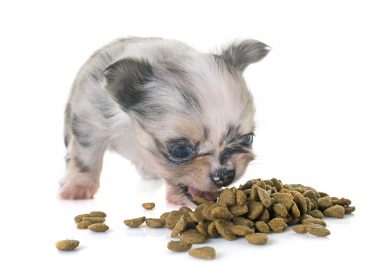
You can also feed dry food exactly as it is instructed in its bag.
Not only is it convenient for feeding and storage, but you can leave it out for your puppy to enjoy at its own pace without fearing of waste or spoilage. You can even use kibbles as a treat once you start training.
It is also said that hard kibble has an oral hygiene advantage due to the friction produced. It helps keep teeth and gums of our friendly canine healthy!
Dry kibbles can be moistened with water or mixed with canned food. It’s not really necessary but it will make your dog’s food tastier.
If you decide to combine dry and wet food, still follow the recommended daily caloric intake for your puppy. In most cases, a 3-ounce can of dog food has 90 calories which are approximately equal to a ¼ cup of dry dog food. Find specific information on the packaging or the website of the brand of your choice.
A veterinarian may help you create a plan on how to properly feed your puppy. Just remember not to overfeed to keep your pet in an ideal condition while growing up.

If your dog is showing symptoms of allergies from feeding her your first pick of puppy food, there are grain-free kibbles, too. Check out these brands:
Make sure you have your little dog checked first so you’ll know the next best dry dog food to get. It will also help you find out what ingredients to avoid.
Feeding palatable wet food for your pups
You’ll find this type of yummy meals in single-serving packets, pouches, and cans.
Semi-moist food is the most expensive way to feed your dog, but it’s worth it since your furry friend will find this tastier than dry kibbles.

Since wet food has a higher moisture content, it can help keep your pup hydrated. After all, not all pets are the same, and some of them don’t drink enough water as they should. It also means that your puppy can enjoy larger meal portions without additional calories, especially if your pup or litter are good eaters.
This type of dog food is also a great choice for canines who lost some of their olfactory senses since wet puppy food has a richer flavor and scent.
If you’re taking care of a weak puppy, wet food will help assure that she’s getting vitamins, proteins, and minerals that they require in order to stay healthy during development. They’re also perfect for dogs with smaller mouths, poorly aligned jaws, and deformities.
Unlike dry kibbles, wet food isn’t as economical. It can’t be left out for a long time, so it’s prone to getting spoiled once it’s opened.
Don’t waste your money by making sure you store leftovers or opened cans in a closed container and place it in the refrigerator.
There are dogs that are more prone to dental issues like plaque when eating wet food. So if you decide to stick with this kind of dog food, you would have to brush your pet’s teeth on a regular basis. Dental chews can be of great help in reducing tartar build-up.
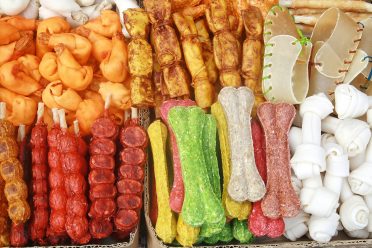
Would it be worth it to buy expensive food for your puppy?
Although it would mostly depend on your budget, the answer is YES. Major dog food companies heavily invest in developing their products and research. They’re constantly upgrading their formulas in order to keep up with all the competition.
A lot of those premium puppy foods have higher nutritional density, which means you can feed your pet less than feeding regular kibbles.
So you’d be on the cutting edge of dog nutrition by choosing premium food.
They may have ingredient profiles that are stable, but bargain brands’ composition varies per batch. You just have to read the packaging to ensure that it covers what your pet needs.
You’ll surely be able to find a puppy food of quality that’s within your price range and remember to buy in small amounts at a time.
Raw feeding: is it good to start feeding your puppy with this food?
No matter the breed, size, or age, puppies can have raw food but a lot of adjustments should be made. You would want to make sure that the diet you’ve chosen will provide the recommended allowances for essential nutrients.

A BARF (Biologically Appropriate Raw Food) or RMB (Raw Meaty Bones) diet is becoming more popular in the canine world.
This diet would normally consist of the animal proteins and meaty bones, vegetables, and may even include grains. But it would be best if you include these raw ingredients every week or two:
- Tiny quantities of liver
- Lungs, heart, and kidney
- White fish
- Oily fish
- Chicken back, neck, wings, and feet
- Eggs
- Pigs trotters
- Ribs of a lamb or beef that has plenty of meat
Although, if you believe and choose to feed your puppy raw food, you have to follow the basic rules and principles involved. As with all kinds of food out there and since no one dog is the same, there are certain risks. Good news is, you can minimize those threats.
If this is your first time trying raw food for your pet, start with natural meals that are sold off-the-shelf. But most raw feeders prepare their dog’s food at home.
You can check out our article for the pros and cons of a raw food diet, as well as proper feeding practices. We also provided links for food recipes and a calculator as a guideline based on your dog’s weight!
Here is the top leading raw puppy food:
FROZEN
- Nature’s Variety Instinct Frozen Raw
- Steve’s Real Dog Food
- Tylee’s Human-Grade Frozen Dog Food
- Primal Pronto Raw Frozen
- Nature’s Logic Raw Frozen Dog Food
FREEZE-DRIED/FROZEN & DEHYDRATED
- Stella & Chewy’s Freeze-Dried Raw Chewy’s Meal Mixers
- Instinct Raw Boost Grain-Free Dry Dog Food
- TruDog FEED ME Freeze-Dried Raw Food
- Primal Pet Foods Freeze-Dried Nuggets
- Canidae Grain-Free PURE Ancestral Red Meat Formula Freeze-Dried Raw Coated Dry Dog Food
Puppy Feeding Schedule: How often to feed a puppy
At some point, those little fur babies will be ready to step up from milk.
They don’t stay puppies for too long that milk replacers or colostrum from their mom wouldn’t be enough to support their development.
That’s why once you’ve decided on which kind of food to give them, your next question would be: How often should I feed a puppy?
First 3 Months
Ensuring that puppies get enough milk during their first few months is critical.
Although most people get their dog or puppy once they’re weaned, there are breeders and owners out there that know how important this is. But it’s possible for some pups to be able to try and eat semi-solid or moistened food as early as 3 weeks.
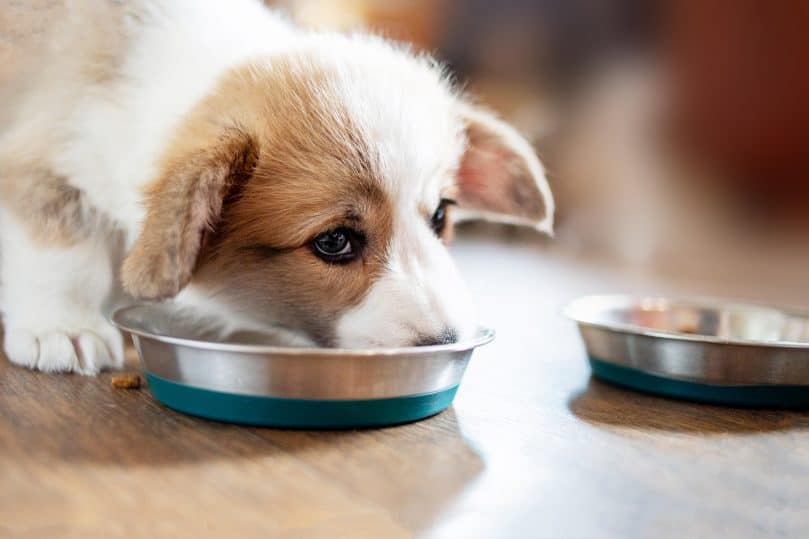
Plus, dogs can often regulate their own intake at this stage. So you can try to place a few amounts of food for the puppy to graze on throughout the day.
Don’t forget that you can’t let out moist or wet puppy food for too long.
If you notice that the little doggos are overeating, try a different strategy with their food. Give them smaller meals at frequent intervals. Generally, it’s suggested to feed puppies of 1-3 months old 4 times a day.
Make sure you’re using puppy food to feed puppies or else you’re robbing the chance for the pup to get essential nutrients.
You can try to stop soaking puppy food or dry kibbles with water or milk and feed it to large-sized dogs by the time they’re 9 or 10 weeks of age. For smaller breeds, that would be around 12 or 13 weeks old.
4 Months to 6 Months
Those huge potbellies should be starting to disappear gradually, as well as their pudginess by 12 weeks of age. You can continue feeding the pup at 4 times a day or decrease it to 3, as long as the puppy isn’t all roly-poly.
If they’re looking kind of round, then continue with the puppy-size portions until her body type matures.
What’s most important during this stage is monitoring the puppy’s weight. They can easily get fat when overfed, especially large breeds. They have a predisposition toward bone problems.
Even if you think that a chubby pup is cute, you’re putting her health at risk.
On the other hand, if a puppy isn’t gaining weight despite getting to eat the right amount of food, there might be an underlying medical condition. At this period, puppies can get parasites, congenital issues, and other health issues that can affect their appetite.
Between 4 to 6 months, puppies still chow down a lot of food. It’s about twice as much per pound when you compare it to an adult canine of the same weight.
6 Months to 12 Months
You can finally start feeding your little furball twice a day! This is the stage where this frequency should generally suffice.
Most canines who are 6 to 12 months old start eating adult food.
Although small breeds can transition by the time they’re 7 to 9 months, larger breeds get to switch between 12 and 14 months of age.
Don’t worry as it’s better to have your pup longer on puppy food than not long enough.
For large to giant breeds, you’d want to give them food that has controlled amounts of calcium. There are commercially made dog foods that are appropriate for the growth of large-sized puppies.
1 Year Old and onwards
By now, that puppy of yours is more or less a grownup. What most owners do is give half-portions of adult dog food together with puppy food as a standard on a daily basis. The only difference when they turn one is if your pup turned into a couch potato.
If the puppy seems to be getting chubby, you may have to deal with it by continuing to feed her twice a day but with reduced portions.

Again, size is a big factor when feeding. So the larger the size of an adult dog, the longer their growth period extends. An example would be the Great Dane, where they may continue to grow even at the age of two.
Even if their growth rate slows down, it’s advisable to continue feeding larger breeds with puppy food to make sure they get the essential nutrients.
As we mentioned earlier, small to medium-sized dogs usually switch to adult dog food before they turn one. Whether it’s dry or wet food, as long as it’s an “all life stages’ food”, you can stick with it.
All throughout, portion control and consistency are the keys to maintaining the ideal weight and body structure.
If you want to avoid your dog being a picky eater, stick to a routine and provide regular amounts of food. Don’t leave it down for your pup for more than 10-20 minutes.
To know what is that ideal weight, take a look at these tables to know the average weight for common small and large breed dogs:
Common Small & Medium-Sized Breeds
| Breed | Average Weight |
| Chihuahua | 5 lbs (2 kg) |
| Pomeranian | 5 lbs (2 kg) |
| Pug | 16 lbs (7 kg) |
| Shih Tzu | 12 lbs (5 kg) |
| Yorkshire Terrier / Yorkie | 7 lbs (3 kg) |
| Maltese | 6 lbs (3 kg) |
| Dachshund / Mini Dachshund | 10 lbs (4.5 kg) |
| Boston Terrier | 18 lbs (8 kg) |
| French Bulldog | 22 lbs (10 kg) |
Common Large-Sized Breeds
| Breed | Average Weight of Males | Average Weight of Females |
| Poodle (Standard) | 65 lbs (30 kg) | 45 lbs (20 kg) |
| Collie | 70 lbs (32 kg) | 60 lbs (27 kg) |
| Golden Retriever | 70 lbs (32 kg) | 60 lbs (27 kg) |
| Labrador Retriever | 75 lbs (34 kg) | 65 lbs (30 kg) |
| German Shepherd | 75 lbs (34 kg) | 60 lbs (27 kg) |
| German Shorthaired Pointer | 65 lbs (30 kg) | 55 lbs (25 kg) |
| Doberman Pinscher | 85 lbs (39 kg) | 75 lbs (34 kg) |
| Rottweiler | 115 lbs (52 kg) | 90 lbs (41 kg) |
| Great Dane | 160 lbs (73 kg) | 130 lbs (59 kg) |
| Mastiff | 200 lbs (91 kg) | 150 lbs (68 kg) |
Once you have an idea of how much your pet weighs, then you can refer to this basic guideline of how many cups you should give her.
Puppy Feeding: Small Breeds VS Large Breeds
Using size-specific formulas, milk replacers, or dog food will benefit certain breed sizes.

Those puppies who will grow to an adult dog that is less than 20 lbs (9 kg) are considered small breeds.
Small-sized dogs grow quickly and as we mentioned, may reach maturity or adulthood earlier than larger breeds, which is around 9 months of age. Purchase small kibbles to help them chew their food easily. Specific-size food for dogs also has all the nutrients that small canines need.
Smaller breeds have higher metabolic rate compared to larger dogs. It means these small but terrible canines need food that will provide higher energy and is more nutrient-dense.
Large-sized puppies, those who will grow up to be 20 lbs and above grows more slowly. Only a few of these larger breeds reach their full size and maturity anywhere from 15-24 months. So they’d need food and additional nutrients while they continue to grow. Especially since they need help to support their size.
Puppy Feeding Chart: how much to feed a puppy
We’ve done the first step of determining the predicted average weight of your puppy once she’s an adult. You can use this chart to know how much food (in cups) to feed your puppy, but remember that the indicated numbers are only a guideline.
| Weight, lbs | Number of cups a day | |||
| 6 to 11 weeks | 3 to 4 months | 5 to 7 months | 8 to 12 months | |
| 3 | ¾ | ⅔ | ½ | ⅓ |
| 5 | 1 ¼ | 1 | ¾ | ⅔ |
| 10 | 1 ¾ | 1 ⅔ | 1 ⅓ | 1 |
| 15 | 2 ½ | 2 ¼ | 1 ¾ | 1 ½ |
| 20 | 3 ¼ | 2 ¾ | 2 ⅓ | 2 |
| 30 | 4 ⅓ | 3 ¾ | 3 ⅓ | 2 ¾ |
| 40 | 5 ½ | 4 ¾ | 4 | 3 ⅓ |
| 60 | 6 ¾ | 6 ½ | 5 ½ | 4 ⅔ |
| 80 | 7 ¾ | 7 ½ | 6 ¾ | 5 ¾ |
| 100 | 8 | 7 ¾ | 7 ½ | 6 ¾ |
*Note that this is just a general idea of how many cups of kibbles can be given to your puppy based on their age and weight. It’s still best to check the instructions at the back of the packaging of your pet’s food or consult the vet.
It is also said that, if you want to promote normal growth for your puppy or litter, they need to be fed with the same number of calories and food. It’s best to do this during their early stage of development, which is around 4 to 12 months of age.
Besides, the cup recommendations of a dog food brand are completely different from the others.
So here’s a chart showing how many calories you should feed your pup every day. It’s based on their weight and includes the daily caloric needs for the different kinds of food you can give her.
| Estimated adult weight, lbs | Dry Food or Kibbles, Cal | Wet Food, Cal | Fresh or Raw Food, Cal |
| 5 | 213 | 202 | 192 |
| 10 | 358 | 340 | 322 |
| 15 | 485 | 461 | 437 |
| 20 | 602 | 572 | 542 |
| 25 | 712 | 676 | 641 |
| 30 | 816 | 775 | 734 |
| 35 | 916 | 870 | 824 |
| 40 | 1013 | 962 | 911 |
| 45 | 1106 | 1051 | 995 |
| 50 | 1197 | 1137 | 1077 |
| 55 | 1286 | 1221 | 1157 |
| 60 | 1372 | 1304 | 1235 |
| 65 | 1457 | 1384 | 1312 |
| 70 | 1541 | 1464 | 1387 |
| 75 | 1622 | 1541 | 1460 |
| 80 | 1703 | 1618 | 1533 |
| 85 | 1782 | 1693 | 1604 |
| 90 | 1860 | 1767 | 1674 |
| 100 | 2013 | 1913 | 1812 |
| 110 | 2162 | 2054 | 1946 |
| 120 | 2308 | 2193 | 207 |
| 130 | 2451 | 2328 | 2206 |
| 140 | 2591 | 2462 | 2332 |
| 150 | 2729 | 2592 | 2456 |
| 170 | 2997 | 2847 | 2697 |
| 190 | 3258 | 3095 | 2932 |
| 210 | 3512 | 3336 | 3161 |
| 230 | 3760 | 3572 | 3384 |
*The values you see here are for canines with activity levels that are average. It can vary depending on your dog’s activity level.
If you’re going to ask help from your vet or breeder with regards to your puppy’s food intake, we recommend that you log her weight and growth.
Although there are lots of information that are available online and in print, it’s way better to have a weekly record of her progress. Then you can compare your puppy’s numbers to the breed-appropriate weight tables and charts.
It will help you adjust your pet’s meals and food intake in order to achieve the proper or average rate of her growth.
You can weigh your dog if you have a scale at home.
Weigh yourself first, then do it again the 2nd time while holding the puppy. Subtract the difference and that would be the little pup’s weight. Don’t worry about an extra ounce or two because either way, no dog (even within the same breed) are built the same.
How long to feed puppy food and when to stop it?
Generally, you can expect the transition from puppy food to adult dog food between 1 to 2 years of age.
Just like with puppies switching to other kinds of food, do it gradually to avoid digestive upsets.
You can talk to your breeder or vet to determine which adult dog food is best for your pet. They can also help you determine the right time to do this change, as well as tips on how to make it easier for the pup to switch.
Puppy feeding and treats?
Whether you just want to spoil your pup or you’re doing training where you motivate and reward her with treats, adjusting her meals is necessary.
It may be hard to resist those puppy dog eyes and treats do make a very effective training tool, but keep the 90/10 rule in mind.
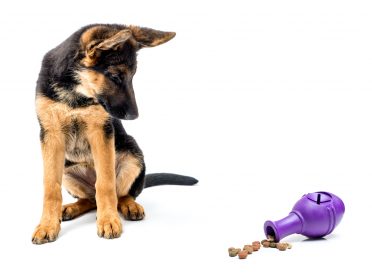
Adjust the amount of food you feed your furry baby by keeping her daily calories around 90%, which should come from her balanced and complete puppy food. Treats are what occupies the other 10%.
This rule will help avoid your puppy from gaining too much weight, as well as other health problems once she’s an adult.
You’re training and building your dog while taking care of her health, so don’t give in whenever she begs.
Table scraps or people food
No matter how lovingly your puppy looks at you, let’s not kid ourselves by saying, “it’s just sometimes” when we toss her a french fry or a strip of bacon. You’ll be surprised that out of nowhere, your dog obese and is crowding you off from the bed or couch!
Not only that, giving your pup table scraps on a daily basis or every meal can create a nutritional imbalance. And there are certain spices or ingredients that can upset your puppy’s stomach.

Don’t be fooled by your dog’s pleading gaze. It’s not a test of your love for her and it’s not an emotional crisis. Believe it or not, it’s the canines’ way of scamming us without knowing the fatal and harmful effects it will have on them.
Not only are you rewarding your pet’s undesirable behaviors that will eventually be hard to break, but there are also human foods that are toxic to dogs. Some of those are:
- Xylitol which is found in gum, baked goods, candy, toothpaste, and some diet foods that use this to sweeten them. It can cause a drop in your dog’s blood sugar and liver failure. Watch out for symptoms such as coordination problems, lethargy, vomiting, or even seizures.
- Avocados have persin and when eaten excessively by your canine, it may cause diarrhea or vomiting. If you want to give your puppy some fruit, small portions of apple chunks and carrots are low-calorie snacks that most pets love.
- Alcohol. Even a little wine or beer can harm your dog really bad. It can cause coordination problems, breathing problems, vomiting and diarrhea, coma, and death. The smaller the dog, the results are much worse.
- Garlic and onions. Whether it’s raw, cooked, dehydrated, or powdered, keep it away from your pet. Excessive consumption can cause poisoning and can kill red blood cells which will lead to anemia. Bring her to the vet once you notice symptoms like vomiting, weakness, and breathing problems.
- Caffeine. Keep anything that has caffeine away from puppies such as chocolate, colas, cocoa, and energy drinks. It’s also found in some painkillers and cold medicine. If your dog ingested even small amounts, take her to the vet.
- Raisins and grapes. Fruits are commonly given to pets as a treat, but not these two as they can cause kidney failure. Even a small amount can make canines sick where they’d vomit over and over. Within the same day of eating a grape or raisin, your dog would noticeably seem depressed and sluggish.
- Dairy. You might think it’s cute and helpful when you share your ice cream with your pet, but milk-based products can cause digestive issues. It can also trigger food allergies.
- Chocolate. The specific problem with this human food is theobromine that’s found in all kinds of chocolate. Unsweetened baking chocolate and dark chocolate are considered the most dangerous. It can cause vomiting, diarrhea, seizures, heart problems, and death.
- Raw Eggs. If you prefer feeding your puppy a raw food diet, most veterinarians think it’s not a good idea to include uncooked eggs in your dog’s meals. There’s a possibility that she’d get food poisoning due to bacteria like E-coli or salmonella.
- Salt. Don’t be tempted to toss or pass those salty chips or pretzels to your canine friend. Having too much salt will make your pet extremely thirsty and could also lead to sodium ion poisoning. You’d know your dog had too much salt when she’s vomiting, having diarrhea, depressed, getting seizures, high temperatures, or even death.
Additional puppy feeding guidelines and advice
It’s best if you’re feeding your puppy with the same schedule as your mealtimes such as breakfast, lunch, and dinner. If you’re feeding her twice a day, give the pup her meals in the morning and an hour or so before her bedtime.
Giving her time allowance will let her do her business before getting some shuteye.
Don’t give food to your puppy the moment you get home as you may encourage separation anxiety. Groom or play with her whenever you say hello.
You can buy dry or canned prescription diets from vets when medically necessary. It’s often used to feed dogs who suffer from diabetes, heart disease, kidney disease, and other serious health concerns.
If you’re going to use vitamins or mineral supplements, it may do more harm than good if it’s utilized incorrectly. So before making any change in your puppy or dog’s diet, consult with a veterinarian first.
For your puppy’s liquid intake, fresh and clean water should always be available for her. Wash her water bowl every day to avoid bacteria. If it gets hot in your area, have multiple water stations inside and outside the house.
And to make sure all these works, have everyone in your home to follow the program.
If there’s anyone in your household who has a soft spot when it comes to dogs, your pet will find and exploit it. One slip up can undo all the hard work and good that you’re trying to do.
There should only be one alpha in every pet owner’s home, YOU.
The bottom line about puppy feeding
Always remember that puppies are different. Setting and following charts or guidelines when it comes to feeding your puppy will help you monitor her growth to make sure she grows up healthy and happy.
Explore your options when choosing the right food for your puppy until you find that tasty diet she’ll love!
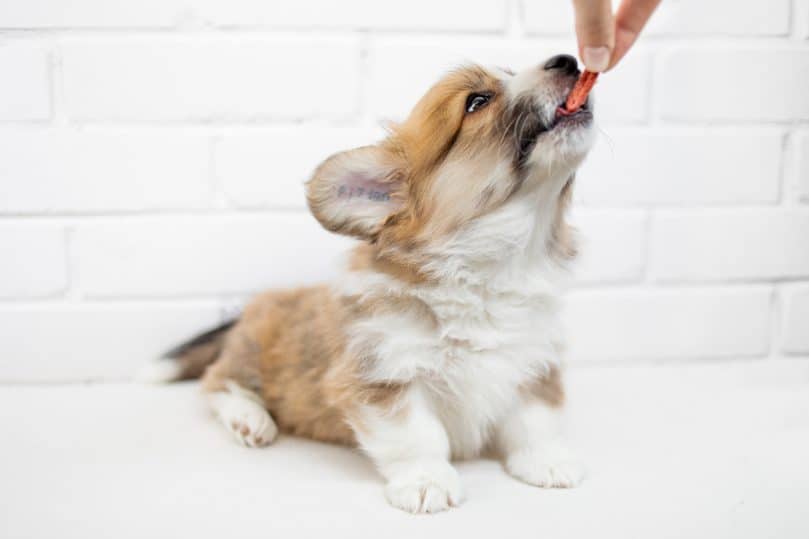
And if you have any questions about you feeding your puppy, her nutritional health, or feeding schedule, don’t hesitate to talk to your breeder or veterinarian. After all, that’s what they’re here for.
What puppy food does your pet love? Do you have any advice or opinion to help new dog owners? Type it all in the comment box below!

Leave a Reply